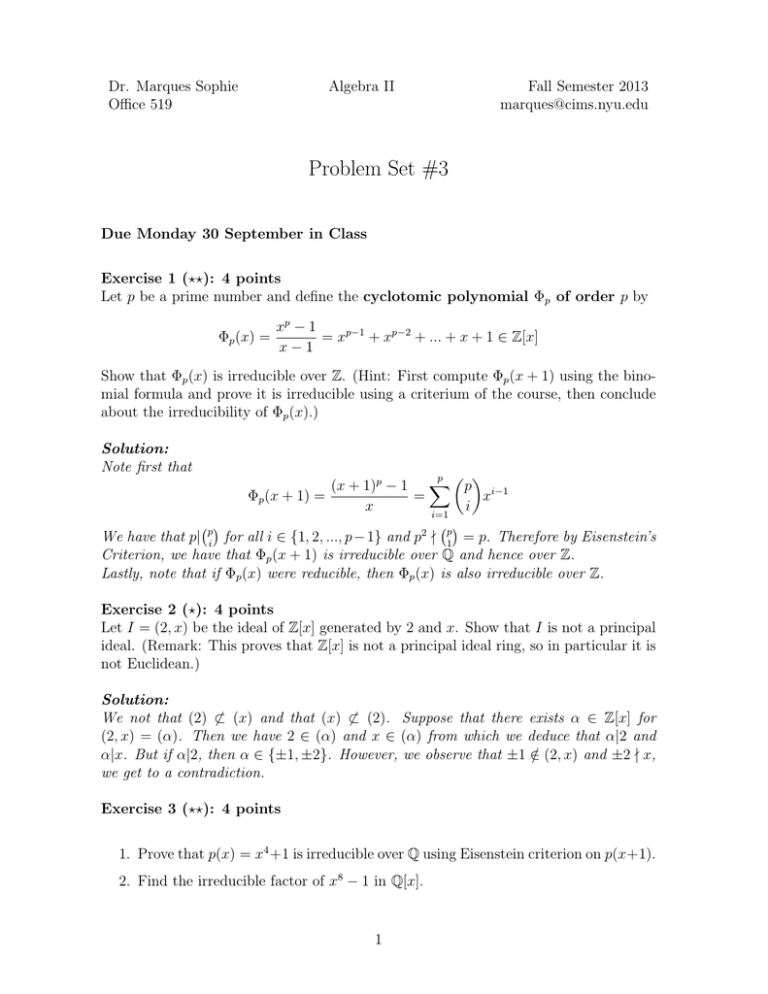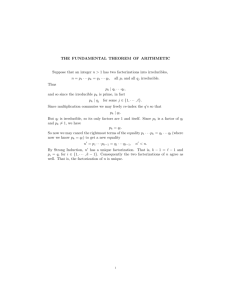Problem Set #3
advertisement

Dr. Marques Sophie
Office 519
Algebra II
Fall Semester 2013
marques@cims.nyu.edu
Problem Set #3
Due Monday 30 September in Class
Exercise 1 (??): 4 points
Let p be a prime number and define the cyclotomic polynomial Φp of order p by
Φp (x) =
xp − 1
= xp−1 + xp−2 + ... + x + 1 ∈ Z[x]
x−1
Show that Φp (x) is irreducible over Z. (Hint: First compute Φp (x + 1) using the binomial formula and prove it is irreducible using a criterium of the course, then conclude
about the irreducibility of Φp (x).)
Solution:
Note first that
p (x + 1)p − 1 X p i−1
=
Φp (x + 1) =
x
x
i
i=1
p
2
We have that p| i for all i ∈ {1, 2, ..., p − 1} and p - p1 = p. Therefore by Eisenstein’s
Criterion, we have that Φp (x + 1) is irreducible over Q and hence over Z.
Lastly, note that if Φp (x) were reducible, then Φp (x) is also irreducible over Z.
Exercise 2 (?): 4 points
Let I = (2, x) be the ideal of Z[x] generated by 2 and x. Show that I is not a principal
ideal. (Remark: This proves that Z[x] is not a principal ideal ring, so in particular it is
not Euclidean.)
Solution:
We not that (2) 6⊂ (x) and that (x) 6⊂ (2). Suppose that there exists α ∈ Z[x] for
(2, x) = (α). Then we have 2 ∈ (α) and x ∈ (α) from which we deduce that α|2 and
α|x. But if α|2, then α ∈ {±1, ±2}. However, we observe that ±1 ∈
/ (2, x) and ±2 - x,
we get to a contradiction.
Exercise 3 (??): 4 points
1. Prove that p(x) = x4 +1 is irreducible over Q using Eisenstein criterion on p(x+1).
2. Find the irreducible factor of x8 − 1 in Q[x].
1
Solution:
1. Observe that p(x+1) = (x+1)4 +1 = x4 +4x3 +6x2 +4x+2 verifies the Eisenstein
criterion for p = 2.
2. x8 − 1 = (x4 − 1)(x4 + 1) = (x2 − 1)(x2 + 1)(x4 + 1) = (x − 1)(x + 1)(x2 + 1)(x4 + 1).
This is a factorization of x8 − 1 into irreducible in Q[x] The first two are linear
then irreducible. The third factor has roots ±i ∈
/ Q; hence it is irreducible. The
last one was studied in point 1.
Exercise 4 (?): 4 points
Determine if the following sets are subspaces of R3 (Give a complete justification to
your answer):
1. V = {(x, y, z)|x, y, z ∈ R and x + y = 1}.
2. V = {(x, y, z)|x, y, z ∈ R and x + 2y + z = 0}.
Solution:
1. (0, 0, 0) is not in V , V is not a subspace of R3 .
2. For each r, s ∈ R, and for each (x, y, z) and (x0 , y 0 , z 0 ) in V , we have x+2y +z = 0
and x0 + 2y 0 + z 0 = 0. We want to prove that r(x, y, z) + s(x0 , y 0 , z 0 ) = (rx +
sx0 , ry + sy 0 , rz + sz 0 ) is in V . But, rx + sx0 + 2(ry + sy 0 ) + (rz + sz 0 ) =
r(x + 2y + z) + s(x0 + 2y 0 + z 0 ) = 0 by the assumptions.
Exercise 5 (?): 4 pointsLet F ⊂ K, both fields, and consider K as a vector space
over F . Let α ∈ K − {0}. Prove that the map Tα : K → K given by Tα (β) = αβ is a
homomorphism. Prove further that it is an isomorphism between K and itself.
Solution:
We have
Tα (β1 + β2 ) = α(β1 + β2 ) = αβ1 + αβ2 = Tα (β1 ) + Tα (β2 )
and for any κ ∈ F, β ∈ K
Tα (κβ) = ακβ = κTα (β)
It is an isomorphism because if we consider the map Uα defined by Uα (β) = α−1 β, it is
its inverse. Indeed, it is easy to check that Uα Tα = Tα Uα = IdK . 1
1
(?) = easy , (??)= medium, (???)= challenge
2








